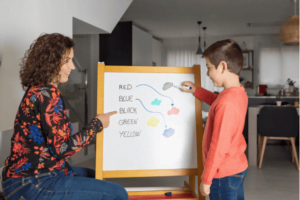Structured Organisation
Our learning environments are carefully curated to provide structured organisation. This ensures that your child feels stable and secure since they are able to predict the lessons for the day. Hence, they are able to focus their energy on discovering and exploring new things, rather than worrying about what comes next.
Q-Pulse establishes this essential element by establishing clear expectations, consistent daily schedules and well-defined boundaries for our students. These consistent routines become familiar to our students, so they enjoy a comforting rhythm throughout their day.



But, that’s not to say that Q-Pulse is entirely rigid! Within these structured periods, Q-Pulse allows for flexibility catering to each student’s individual needs and wants.
Our experienced staff personalise the schedules so that every child has space to learn more about their interests. We embrace moments of spontaneity and fun. This ensures a balance between predictability and responsiveness.
The below two approaches allow for Q-Pulse to provide structured organisation to your child’s learning.
TEACCH Approach
TEACCH is an acronym for the Treatment and Education of Autistic and Related Communication Handicapped Children. It emphasises structure and predictability to curate a supportive learning environment that caters to students with diverse learning styles, particularly those on the autism spectrum.
The TEACCH Approach aims to promote communication, social interaction and talent development.
ABA & AVBA Approach
AVBA is an acronym for Applied Verbal Behavioural Analysis, while ABA is an acronym for Applied Behavioural Analysis.
ABA places an emphasis on learning, by making use of how the individual interacts with their environment.
Derived from the principles of ABA, AVBA aims to focus on communication and language skills. This allows our students with communication challenges to better express themselves.


